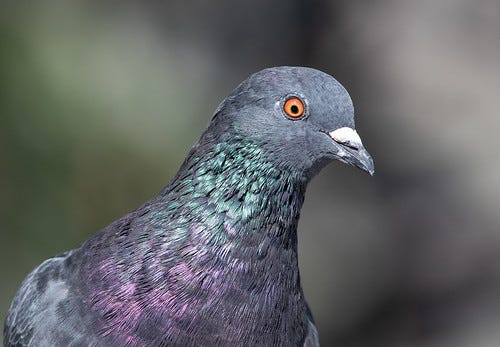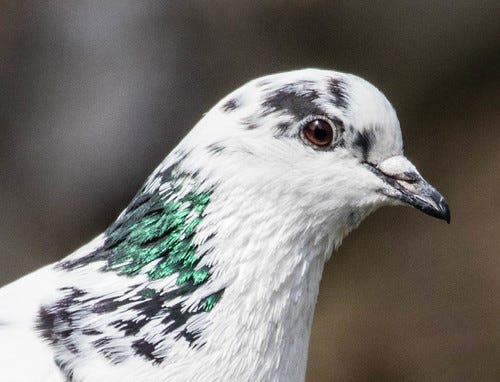A Question of Balance
In which Laura becomes a dizzy dame.
(Listen to the radio version here.)
A few weeks ago, as I was recovering from my December surgery, I started having severe dizzy spells. On January 29, the dizziness got so bad, with a terrifying spinning sensation, that Russ took me to the ER. The EKG confirmed that my heart was doing okay, and a brain MRI suggested that nothing bad was going on upstairs, so they sent me home with an order for a heart monitor to wear for a few days and an appointment with a physical therapist. The MyChart visit summary read (and I am not making this up), “Reason for visit: Dizziness. Diagnosis: Dizziness.”
I was still so dizzy that I had to hold onto walls to get from room to room. I had no idea whether this was going to be “the new me”—a scary condition I’d have to cope with for the rest of my life. When she was in her 90s and living with us, I used to do daily balance exercises with my mother-in-law to help prevent falls, and I was afraid this would be the kind of help I’d get from the physical therapist, but nope. She figured out right off that I had something called "benign paroxysmal positional vertigo" (BPPV)—a big name for a very easily corrected condition.

Tiny calcium crystals called canaliths are in a part of the inner ear called the utricle—their job is to sense head movements. But sometimes those crystals detach and make their way into the semicircular canals whose job is to help with balance. When the tiny crystals get into the wrong place, head movements can send crazy signals to the brain, and an involuntary reflex makes the eyes flutter, not only making the sufferer feel off-balance but also that the world really is spinning. Our bedroom has white walls and a pink cornice, and whenever this happened to me as I was getting up, the pink line jumped back and forth crazily for a few seconds.
To be certain that I had these calcium crystals in my semicircular canals, the physical therapist gave me a pair of high-tech dark goggles equipped with a camera so she could see on a computer screen if my eyes started fluttering when she had me lie on the examining table and turn my head to the left and right.
Sure enough, when I turned one way, the eyes went batty, so this was a clear case of BPPV in my right ear. Decades ago, an ENT from Portland, Oregon, named John Epley worked out an ingenious maneuver to send those crystals floating in the semicircular canals back to the utricle where they belong.
My physical therapist had me sit on the table and turn my head 45º to the right for 30 seconds. Then she supported my head in that position while I quickly leaned back so I was lying with my head just beyond the table and slightly below my shoulders, supported by her hands. I kept it at that same 45º angle for 30 seconds, and then turned my head 90º to the left, still supported by her hands, and held it there for 30 seconds. Then I turned my whole body and head another 90º to the left, so that my head was facing 45º down, still supported by her hands. I held that position for 30 seconds and voila! A miracle happened! I’m well!
Well, I was fine for a couple of days, but then it happened again one morning when I was getting up. Fortunately, the physical therapist had sent me home with a brochure showing me how to do this maneuver at home with Russ holding my head. That worked for the day, and when it happened the next morning, I tried it with my shoulders on a pillow so that I could hold my head below my shoulders, supported by the bed. That worked just fine, so now I can do this maneuver on my own without any help. It’s been four days since I felt that bizarre spinning or any dizziness at all, and I am SO relieved to know that if it happens again, I can quickly and easily take care of it myself.
Learning about those calcium crystals in the human inner ear of course made me delve into my old ornithology reference books and online to learn more about the avian inner ear. The inner ear of vertebrates, including both birds and people, controls two senses. The cochlear system is dedicated to hearing and the vestibular system to our sense of balance. Bird ears have the exact same structures as ours only with a more complex design—they must hear and process sounds in a wider range of frequencies at a much more rapid speed than we can, and they must also have an exquisite sense of balance to fly through open air and among tree branches, making instant shifts in every direction to capture prey and to elude predators.
So suddenly I'm wondering if BPPV ever happens to birds. I was so disoriented just walking from room to room—how could a bird handle such a situation? Not one reference had the answer to that question, but I came across a disturbing number of references to research projects, mostly focused on pigeons, wherein the researchers damaged a specific structure in a bird’s inner ear, recorded the bird’s distress and disoriented movements, and then "sacrificed" the poor thing. We humans don't always think through or care about who pays for our inquisitiveness, but curiosity kills a lot more than cats.





Very informative - thanks!
A dizzy dame huh?? Funny! That must have been scary. I hope your condition continues to improve. Cheers!